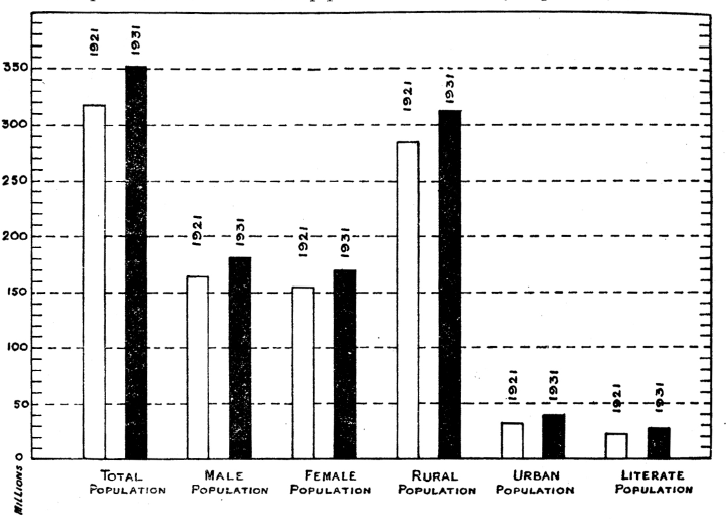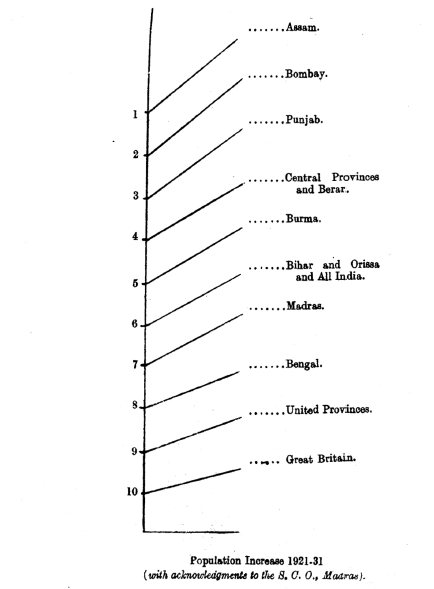Census India 1931: The Population Problem
(Created page with "{| class="wikitable" |- |colspan="0"|<div style="font-size:100%"> This article is an extract from <br/> CENSUS OF INDIA, 1931<br/> Report by<br/> J. H. HUTTON, C.I.E., D...") |
Latest revision as of 19:15, 29 June 2016
This article is an extract from CENSUS OF INDIA, 1931 Report by J. H. HUTTON, C.I.E., D.Sc., F.A.S.B., Corresponding Member of the Anthropologische Gesselschaft of Vienna. Delhi: Manager of Publications 1933 (Hutton was the Census Commissioner for India) Indpaedia is an archive. It neither agrees nor disagrees |
[edit] The Population Problem
[edit] Nature of the problem
Attention has already been drawn to the grave increase in the population of this country. The actual figure of the increase alone is little under thirty-four million, a figure approaching equality with that of the total population of France or Italy and appreciably greater than that of such important European powers as Poland and Spain. The population now even exceeds the latest estimate of the popu ation of China, so that India now heads the list of all the countries in the world in the number of her inhabitants. This increase, however, is from most points of view a cause for alarm rather than for satisfaction.
The total literate population of India in 1921 was 22,623,651 and is now 28,131,315, so that the mere increase of population during the intervening period has exceeded the former figure by 11 million, that is by 50 per cent., and still exceeds the later own percent Even in Travancore State, where the percentage of literacy is much higher than in most parts of India, but where the population has increased by 27 per cent., the proportion of literacy has fallen from 24.2 per cent. in 1921 to 23.9 per cent in 1931 though in India as a whole it has risen from 7 per cent. to 8 per cent.
Recent writers on the population question in India, e.g., Wattal and Ranadive, have directed their attention primarily to the question of food production. Their argument is that the population of India is already living permanently on the verge of scarcity and any increase is bound to result in an insufficiency of the food supply. Recent experience, however, throws doubt on this theory ; the general slump in the price of food, and the difficulty found by cultivators in selling their produce, suggest that the danger of a shortage of the food supply is not the most serious aspect of the question. It is not argued that this is not a danger to be reckoned with, and in any case the maximum population possible is very far from identical with the maximum population desirable, since the rise of population on the subsistence margin must reduce the standard of living, but it would seem that the point has not yet been reached at which the ability of the country to feed its occupants is seriously taxed. The position of economists in regard to the west now appears to be that " the devastating torrent of babies " is being reduced to a trickle, and that even if it were swelled again the rapid developments both mechanical and biological that are taking place in the world production of food, would be more than sufficient to cope with the flood, so that it is progressively easier to obtain subsistence. It may be doubted whether either supposition is yet applicable to Indian conditions.
In the first place there are as yet no indications of any tendency on the part of the countryman to modify his view of the blessedness of the man who has a quiverful of sons and is not ashamed to meet his enemy in the gate, and, in the second, little sign that agriculture is likely to be appreciably affected during the next decade by means such as those which have so greatly increased wheat production on the American continent. It is however obvious that apart from the law of diminishing returns the ability of agriculture to provide an occupation is limited. • In Europe it has been estimated that the maximum population which can be supported by agricultural occupations is 250 to the sq. mile, while an estimate of somewhat higher density has been made in the case of the United States of America, and the island of Porto Rico in the West Indies has an agricultural population of nearly 400 to the sq. mile.
The number i s as we have seen, very much greater than this in many parts of India, and the rural population which attains the extraordinary density mentioned of parts of Bengal and of the Malabar Coast indicates the extent to which fertile land intensively cultivated together with fish-yielding waters could sustain a population whose material wants are reduced to the minimum by the natural environment of a tropical climate. These, of course, are extreme cases taken from the two most fertile parts of India,* but generally speaking the maximum density of the agricultural population can be far greater in India than in Europe, not only on account of the greater fertility of the land but on account of the diminution in the absolute necessities of life corresponding to a less rigorous climate.
The real difficulty is that to cultivate on anything like economic lines the number of individuals that can work on a given area of ground is limited ; and though the food product may be ample for many more than that number, a large increase in the population must either lead to excessive subdivision of the areas cultivated, and so to a diminution in production on account of uneconomic holdings, or on the other hand, to a floating population which is not engaged in agriculture and which has nothing to exchange with the producers for the food which it requires. The employment of this surplus in industrial activity would of course, meet the difficulty for a time, but can only prove a permanent cure if the increase of the population be limited not only to the food producible but also to the saturation point of the demand for industrial labour. When the latter point is passed, as in the United Kingdom, where the increase in population during the last decade was approximately equivalent to the number of unemployed in 1931, unemployment will arise and the fact that the food supply is adequate is to this extent irrelevant.
As in some parts of Europe, life on the land as a cultivator is an end in itself rather than a mere means of production of victuals, hence the real danger of a growth of population which must suffer discomfort because this end becomes rapidly more difficult of realisation. The present problem in India would therefore seem to be less the actual total increase of the population, than the increase of that portion of the population, by, far the greater part of course, which is occupied in agriculture and allied pursuits, i.e., the population represented by sub-class I of the Occupation Table ; and an additional complication of the problem appears in the fact that the cultivating classes in India generally lack the capital required for the extension of cultivation beyond the existing margin, particularly where the cultivation practised is already dependent on a somewhat problematic rainfall.
Mechanical improvements which reduce the need for labour are a doubtful palliative, though no such doubt attaches to biological improvements, enabling a better crop to be obtained from a smaller area. Labour-saving devices will do little for a peasantry whose work takes up part only of the year and certainly they will not enable a greater number of peasants to live on the same area of land where there is neither demand nor market facilities for the minor products of agriculture which contribute to the income of the European small holder or on which, such as poultry, pigs or potatoes, he may principally depend.
[edit] Remedies
It appears to be the general opinion of Indian economists who Remedies discuss the population problem of this country that the only practical method of limiting the population is by the introduction of artificial methods of birth control, though it is not easy to exaggerate the difficulties of introducing such methods in a country where the vast majority of the population regard the propagation of male offspring as religious duty and the reproach of barrenness as a terrible punishment for crimes committed in a former incarnation. It is justly pointed out by the Census Superintendent of Mysore State that the practice of universal and of early marriage is a social custom and is not, in fact, followed from religious motives, but it is almost always religious arguments which are put forward in opposition to a change in social custom by any society anywhere, and though the religious sanction may be the result rather than the cause of the social custom, this fact only gives the sanction greater force.
Nevertheless a definite movement towards artificial birth-control appears to be taking place and is perhaps less hampered by misplaced prudery than in some countries which claim to be more civilized ; thus not only is artificial control publicly advocated by a number of medical writers but Madras can boast a Neo-Malthusian League with two Maharajas, three High Court judges and four or five men very prominent in public life as its sponsors. Meanwhile it would appear, in view of the present rate of increase, that efforts to reduce the rate of infantile mortality should be preceded by precautions to reduce the birth-rate, and that if the luxury of ' baby weeks ' be permitted they should at least be accompanied by instruction in birthcontrol. A move in this direction has already been made by the Government of Mysore State, which in 1930 sanctioned the establishment of birth-control clinics in the four principal hospitals of the State.
There are perhaps other methods of checking an excessive increase in population. It has been clearly demonstrated in Europe that a rise of the standard in living is normally accompanied by a fall in the birth-rate, and the same principle no doubt operates in this country ; but, even while we must admit the truth of Bacon's aphorism that " Repletion is an Enemy to Generation ", a mere superfluity of food supply is not enough, as it only enables the possessor to breed up to the subsistence level again. In order that a higher standard of living may affect the rate of reproduction it is apparent that not only is an increase in education and culture involved, since it seems definitely established that intellectual activity acts as a check upon fertility, but also the psychological appreciation of a higher probability of survival.
Recent studies of the population problem in the Pacific by Rivers, Pitt-Rivers, Roberts and others have clearly demonstrated the importance of psychological factors as affecting the increase or decrease of the population, and although the environment is generally entirely different in India, that is no reason for supposing that psychology is any less important here in its action on the rate of reproduction. It is also likely that a changed outlook, in which a greater value was attached to the goods of this world and less regard paid to the speculative possibilities of the next, would operate in the same direction ; but it seems doubtful if a materialistic standpoint would commend itself to Indian culture.

